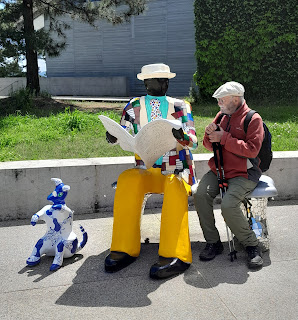Naoshima, 09.05.24
The story of Naoshima as an art island began in 1985 when the president and founder of Fukutake Publishing, Tetsuhiko Fukutake and the mayor of Naoshima, Chikatsugu Miyake met and discussed ways of creating a place where children from all over the world could gather in a pristine area for education and recreation. It started as a dream of two men. Incidentally the grandson of Tetsuhiko Fukutake, Hideaki Fukutaki, lives in Auckland and is the CEO of STILL in New Zealand.
The first development, under the supervision of architect Tadeo Ando, was the establishment of the Naoshima International Youth Camp where children can experience the natural surroundings of the Setouchi region.
It followed by the opening of the Benesse House Museum in 1992 which was both a gallery and a hotel. Again, it was designed by Tadeo Ando who won the Pritzker Price for architecture. His style of architecture reminds one of Le Corbusier. Simple structures built mainly in concrete and in Ando's style reflects the Japanese religious term of Zen, focusing of simplicity and inner feeling.
We stayed at Benesse House and whether it was this Zen aspect of the building it would rank among the best places with stayed in Japan or for that matter anywhere else. The bare concrete walls were not brutal or intimidating but in a strange way rather cosy and coupled with the wooden accessories and artworks gave a feeling of warmth and homeliness. I would love to go back.
 |
Hotel Entrance |
The opening of Benesse House was followed in 1994 by an outdoor artwork exhibition which was to showcase the power of contemporary art when displayed in a rich and natural environment. In the wake of this exhibition many site-specific works of art were commissioned.
Then followed in 1995 the Oval House purely for accommodation, and over the years several smaller art projects until in 2004 the Chichu art museum was opened. It is all built underground and proposes an experience of art, nature and architecture. There is a permanent exhibition of Claude Monet, James Turrell and Walter de Maria.
Time for us anyway to get out and discover the island. It can all be done on foot as the area of the art project is not that big. Again, we had that feeling of being on a Mediterranean island with lush vegetation and the smell of the sea.
We walked uphill for quite a while taking in the views over the ocean and the coastline and in the distance the mainland of Honshu. The walking was not on a track but a small country road with hardly any traffic. Occasionally other tourists passed by but they were on bicycles. Every now and then a work of art would be on the side of the road, very unexpected and unusual. See picture gallery below.
 |
Work of Art |
Lovely walking through the forest, passed a small lake and into a village where we hoped to get some lunch. Not much chance but on the way home we found a little restaurant where they had one last single beer on offer which we shared between us plus two strawberry ice-creams.
 |
The Lake |
Got home in good time where we had another look at the artworks and a welcome drink in the museum cafe. I also made a reservation for dinner in the French restaurant on site. Just needed a change from the Japanese fare and quite frankly we did not want another one of those Kaiseki dinners which by now we had had several times.
We ordered a simple salad to start with, Christine then had a steak and I had panfried fish. Some vegetables came with it and some very good sour dough bread with butter and an excellent Japanese olive oil. New to me Japanese olive oil but of exceptional quality. The desserts were fine too and the whole meal was a delight.
 |
Salad! |
 |
Steak! |
 |
Fish! |
 |
Cheese! |
 |
| Dessert! |
Picture Gallery of works of art!
 |
The Red Pumpkin |
 |
The Yellow Pumpkin |
 |
The Bubble Bus Stop |






Comments
Post a Comment